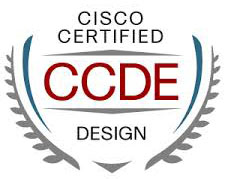درباره دوره آموزشی CCDE Design سیسکو بیشتر بدانید
دوره CCDE گواهینامه ی بسیار تخصصی مهندسین طراح درسطح بالا برای هدایت تیم زیر ساخت و شبکه به منظور معماری وظایف تیم کاری که درخواست مشخص نمودن نیازهای تجاری، بودجه و محدودیت های عملکردی را دارند در طراحی یک شبکه همگرا می باشد. برنامه آموزشی CCDE طراحان را برای ارائه راهکار زیرساخت شبکه های بزرگ مشتریان آماده می سازد.
دارندگان معتبر و فعال این گواهینامه در حد دانش و مهارت بسیار بالا شناخته می شوند. دانش عمیق شبکه که این گواهینامه به همراه دارد اطمینان بخش این است که دارندگانش واجد شرایط انجام پروژههای چالشی می باشند.

محتویات دوره CCDE Design
CCDE مهارت های اولیه درطراحی زیر ساخت شبکه های بزرگ را تایید می کند. این گواهینامه اثبات توانایی ارائه راهکارهای آدرس دهی، طراحی، یکپارچه سازی، بهره وری، عملکرد، امنیت شبکه و همچنین پشتیبانی مداوم زیر ساخت شبکه را به اثبات می رساند.
اهداف دوره CCDE Design
پس از اتمام موفقیت آمیز دوره ی CCDE، داوطلب قادر خواهد بود:
- طراحی زیرساخت و اصول و مبانی شبکه های پیشرفته را ارزیابی نماید.
- توانایی ارائه راهکارهای آدرس دهی، طراحی، یکپارچه سازی، بهره وری، عملکرد، امنیت و پشتیبانی مداوم زیر ساخت شبکه را نشان دهد.

مخاطبین دوره CCDE Design
- علاقه مندان به مباحث طراحی پیشرفته شبکه
- مدیران و کارشناسان IT، ISP ها و مراکز Service Provider
- متخصصان مراکز داده

مشخصه های دوره CCDE Design
- Course Overview
- Exam Overview
- Technologies Covered
- Study Material
- EIGRP Design and Optimization Concepts
- OSPF Design and Optimization Concepts
- BGP Design and Optimization Concepts
- MPLS Unicast Routing
- MPLS VPN
- QoS
- IS-IS
- Security
- Multicasting
سر فصل های اصلی دوره CCDE Design سیسکو
- Layer 2 control plan
- Describe fast convergence techniques and mechanisms
- Describe loop detection and mitigation protocols
- Describe mechanisms that are available for creating loop-free topologies
- Describe the impact of transport mechanisms and their interaction with routing protocols over different types of links
- Describe multicast routing concepts
- Describe the impact of fault isolation and resiliency on network design
- Layer 3 control plane
- Describe route aggregation concepts and techniques
- Describe the theory and application of network topology layering
- Describe the theory and application of network topology abstraction
- Describe the impact of fault isolation and resiliency on network design or network reliability
- Describe metric-based traffic flow and modification
- Describe fast convergence techniques and mechanisms
- Describe factors affecting convergence
- Describe unicast routing protocol operation (OSPF, EIGRP, IS-IS, BGP, and RIP) in relation to network design
- Describe the interaction between routing protocols and topologies
- Describe generic routing and addressing concepts
- Describe multicast routing concepts
- Describe IPv6 concepts and operation
- Network virtualization
- Describe Layer 2 and Layer 3 tunneling technologies
- Analyze the implementation of tunneling
- Design consideration
- Analyze various Quality of Service (QoS) performance metrics
- Describe types of QoS techniques
- Identify QoS strategies based on customer requirements
- Identify network management requirements
- Identify network application reporting requirements
- Describe technologies, tools, and protocols used for network management
- Describe the reference models and processes used in network management, such as FCAPS, ITIL, and TOGA
- Describe best practices for protecting network infrastructure
- Describe best practices for protecting network services
- Describe tools and technologies for identity management
- Describe tools and technologies for 802.11 wireless deployment
- Describe tools and technologies for optical deployment
- Describe tools and technologies for SAN fabric deployment
دوره های مرتبط:
|
|









